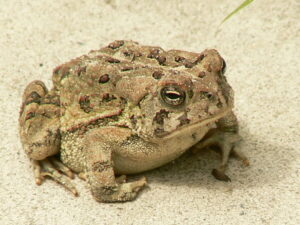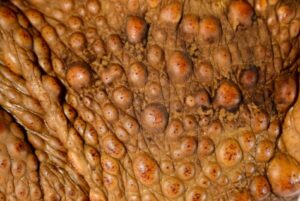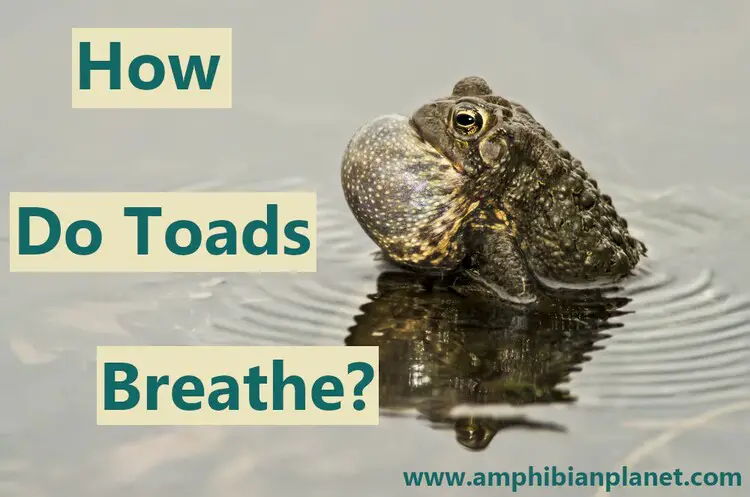If you ever look at a toad, you will notice it looks so much different from other amphibians. It has dry rough skin with a bumpy texture, and rather than hop like most frogs, it will mostly move around by crawling. But have you ever wondered how toads breathe?
Toads breathe using their lungs as well as through their skin and thin membranes in their mouth and throat. They start their lives as tadpoles with gills for breathing in the water. Over time, the tadpoles will lose their gills and transform into adult toads with lungs.
That being said, it is important to note that how toads take air into their lungs is slightly different from humans. They do not have a rib cage or diaphragm to move air in and out of their lungs as we do.
Instead, they move air in and out of their lungs through a process known as “gular pumping”, also known as “buccal pumping” (more information on that below).
Toad Tadpoles Breathe Through Their Gills
Toads start their lives as tiny tadpoles. Tadpoles are very different from adult toads; this is because they’re adapted for a fully aquatic life (life in the water), while adult toads are adapted for a mostly terrestrial life (life on land).
Toad tadpoles have gills on either side of their head, and a flat paddle-like tail fin to help them move in the water.

At this stage, toad tadpoles breathe in the water through their gills, just like fish.
Their gills have an extensive capillary network very close to the skin surface; Oxygen that is dissolved in the water that comes in contact with their gills is absorbed into their bloodstream via diffusion.
At the same time, carbon dioxide from the bloodstream passes through the gills and is diffused into the water.
Sometimes, Toad Tadpoles Breathe Air
Tadpoles sometimes live in water with low oxygen levels – where their gills (and skin) cannot absorb sufficient oxygen. This means they also need to breathe air. For this reason, most toad tadpole species also develop lungs in addition to their gills.
When they first hatch, the tadpoles are too feeble to break through the water’s surface for a gulp of air. To get around this, they “bubble-suck”.
To do this, they first stick their open mouths to the underside of the water’s surface. They then open their jaws wide and suck at the water’s surface. Doing this creates an air pocket that they can pinch off by quickly closing their jaws.
After they close their mouth, a portion of the fresh air bubble is forced down into their lungs
Since the tadpoles are tiny, they usually cannot absorb the entire air bubble, and the excess is burped out as a small bubble, after which it floats back up to the water’s surface.
Once the tadpoles get bigger, they will be strong enough to break through the water’s surface for a gulp of air.
Tadpoles Transform Into Toadlets
After a period of 2 to 3 weeks to as long as over 3 months (depending on the species), the tadpoles go through a process known as metamorphosis. In this process, they lose the features that help them live in the water and develop features more suitable for living on land.

During this process;
- They lose their gills and get well-developed lungs for breathing air
- The tail shortens and is eventually absorbed into the body
- They develop strong legs for moving on land
Once this process is complete, tiny toadlets (small toads), typically half an inch long will leave the water and live a fully terrestrial life.
These toadlets will grow into adult toads and once they mature, they will go back to the water to breed and lay their eggs.
Adult Toads Breathe Using Their Lungs
Adult toads have well-developed lungs which they use to breathe air. They take air through their nostrils, and down into their lungs.

However, as mentioned earlier, how toads take air into their lungs is slightly different from humans. Toads do not have a rib cage or diaphragm to move air in and out of their lungs as we do.
Instead, they move air in and out of their lungs through a process known as “gular pumping”, also known as “buccal pumping”.
How Gular Pumping Works
This is a process of moving air in and out of the lungs through the use of the mouth and throat muscles.
To breathe in, the toad will lower the floor of its mouth, which causes the throat to expand. Air then rushes into the throat, through the mouth, and through the open nostrils.
The toad will then close its nostrils, and raise the floor of its mouth, which causes the throat to contract, and pushes the air into the lungs.
Once the air is in the lungs, oxygen from the air is then absorbed into the toads’ bloodstream. At the same time, carbon dioxide from the bloodstream is diffused into the air.
To breathe out, the toad will lower the floor of its mouth, which causes the throat to expand and draws the air from the lungs, and into the mouth. It will then open its nostrils, and raise the floor of its mouth, to push the air out of the nostrils.
All this happens in split seconds, and without any conscious effort from the toad, just like how we breathe without thinking about it
They Also Breathe Through Their Skin
Amphibian lungs are quite primitive when compared to our own. They usually can not give a toad all the oxygen it needs. For this reason, toads also have the ability to breathe through their skin and thin membranes in their mouth and throat to get extra oxygen.

The skin contains a large network of capillaries and other blood vessels close to the surface. The oxygen that comes in contact with their skin and membranes is absorbed into the bloodstream via diffusion.
At the same time, carbon dioxide from the bloodstream passes through the skin and membranes and is diffused into the atmosphere.
This process of “skin breathing” is known as cutaneous respiration is very similar to what happens inside of our lungs.
How Do Toads Breathe Underwater?
Toads breathe underwater via cutaneous respiration. Dissolved oxygen in the water that comes in contact with their skin is absorbed into the bloodstream via diffusion. At the same time, carbon dioxide from the bloodstream passes through the skin and is diffused into the water.

However, this method of breathing does not give them all the oxygen they need, so they can only be underwater for a limited time before they have to resurface to breathe air with their lungs.
Exactly how long a toad can stay underwater depends on how much oxygen it needs vs how much oxygen it can absorb from the water through its skin.
This is usually affected by: how much dissolved oxygen there is in the water, the temperature, and how active the toad is
1. How Much Oxygen There Is in the Water
Fast-moving or ‘stirred up’ water generally contains more oxygen than still water. This is because oxygen from the atmosphere mixes with the water easier.
If water is very still, oxygen only dissolves on the water’s surface, and anything below the upper layer of the water will have a low oxygen content.
Additionally, aquatic plants and algae also affect how dissolved oxygen is in a body of water. During the daylight hours, they produce oxygen through photosynthesis and release it into the water.
At night, aquatic plants and algae will use up dissolved oxygen in the water via aerobic respiration and release carbon dioxide into the water.
For these reasons, the concentrations of dissolved oxygen in water with lots of photosynthesizing aquatic vegetation will be highest in the mid-to-late afternoon when photosynthesis rates are greatest and will reach the lowest concentrations just before the sun rises the next morning.
Also, water with lots of decaying plants will have a lower oxygen content. This is because the bacteria responsible for the process of decomposition use oxygen and release carbon dioxide into the water, reducing the oxygen content of the water.
Toads can stay underwater in water with a high oxygen content for much longer than they can in water with low oxygen content.
2. The Temperature
Toads are ectothermic (cold-blooded) animals, so the environmental temperatures will affect their rate of metabolism. At higher temperatures, they will have a higher metabolic rate, meaning they have a greater oxygen demand.
At lower temperatures, the opposite is true. Toads will have a lower metabolic rate meaning they have a lower oxygen demand.
Also, the temperature will affect the oxygen content of the water. More oxygen will dissolve into the water at colder temperatures, than at warmer temperatures.
This means toads can stay underwater at lower temperatures for much longer than they can at warmer temperatures.
3. How Active the Toad Is
Activity affects how much oxygen the body needs. Think about it, when we are running or jogging, we breathe heavier and in much quicker breaths than when we are at laying on the couch.
For toads, this is also true. They will have a higher oxygen demand when they are very active in the water (escaping a predator for example), and a lower oxygen demand when they are inactive.
For this reason, toads will be able to stay underwater when at rest for much longer than when they are active.
How Do Toads Breathe During Hibernation?
During the winter, toads hibernate underground to protect themselves from freezing temperatures. They typically hibernate in abandoned small animal burrows, under rocks, or will dig their own burrows in soft soil (toads can dig over 2 feet to get below the frost line).
During hibernation, toads do not get as much oxygen as they do when they are above ground, so suffocation is a real possibility. However, they have a way to get around this.
Since toads are ectothermic (cold-blooded) animals, the lower temperatures during the winter drastically lower their metabolism and reduce their oxygen demand.
The oxygen demand is lowered to the point where all the oxygen needs can be met by absorbing oxygen from the surrounding soil via the skin (cutaneous respiration).
Since the lungs are not in use, most of the blood moves to the skin to maximize the amount of oxygen absorbed. This can sometimes be observed when the light skin on their bellies turns pink to reddish from the increased blood flow.
In this way, toads can stay underground all winter long without having to surface for oxygen.
Frequently Asked Questions
How do toads breathe underwater? Toads breathe underwater by absorbing dissolved oxygen in the water through their skin and into their bloodstream via diffusion. At the same time, carbon dioxide from the bloodstream passes through the skin and is diffused into the water.
Do toads have gills or lungs? As tadpoles, toads have gills that they use to breathe in the water. With time, the tadpoles go through a process known as metamorphosis in which they will lose their gills and develop functional lungs which they use to breathe air on land.
Do toads breathe through their skin? Like all amphibians, toads have the ability to breathe through their skin. The oxygen that comes in contact with their skin is absorbed into their bloodstream via diffusion – and carbon dioxide from the bloodstream passes through the skin and is diffused into the atmosphere.
Final Thoughts
Most toads start their lives as tiny fully aquatic tadpoles. At this stage, toads breathe in the water through their gills, just like fish. Sometimes tadpoles live in water with low levels of dissolved oxygen where they can not get all the oxygen they need through their gills.
To get around this, toad tadpoles also develop lungs which they use to breathe air from the surface of the water by “bubble sucking.”
Over time the tadpoles will lose their gills and develop into tiny toadlets that live entirely on land. These toadlets will grow into adult toads.
Adult toads breathe using their lungs, but they can also breathe through their skin and thin membranes in their mouths and throat.
During hibernation, toads breathe entirely through their blood-rich skin.


